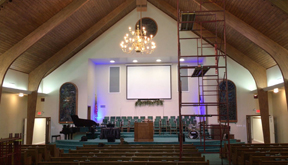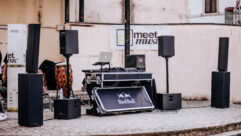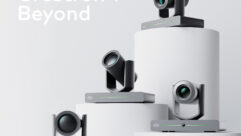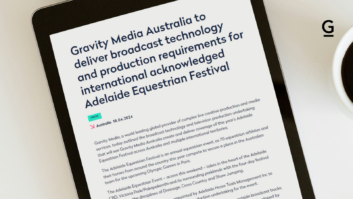
SVC Podcast – Show Notes – Show 179-1
In this edition of the SVC Podcast, Contributing Editor Bennett Liles talks with Carl Lowrance of Lowrance Sound Company in Union City, Tennessee about the lighting and sound installations done for Hillcrest Baptist Church in nearby Dyersburg. The church had a problem with light coming through the stained glass windows and causing a strange mix of colors at the pulpit. Carl outlines the lighting improvement made with elektraLite Eyeball 5 in 1 LED lighting fixtures.
TO GO TO PART 2 OF THIS PODCAST
Links of interest:
- Lowrance Sound Company in Union City, Tennessee
- elektraLite lighting instruments
- Hillcrest Baptist Church in Dyersburg, Tennessee
Download Podcast Here:
https://s3.amazonaws.com/nb-svc/public/public/179-1_Hillcrest_Baptist_Lo…
Transcript-
This is the SVC Podcast from Sound & Video Contractor Magazine with Carl Lowrance of Lowrance Sound Company. Show notes and equipment links for the podcast are on the web site of Sound & Video Contractor Magazine at svconline.com.
Hillcrest Baptist Church in Dyersburg, Tennessee has beautiful stained glass windows but they were causing a color wash over the pulpit and something had to be done. Lowrance Sound Company was called in from Union City and they installed elektraLite instruments and the lighting problem was solved. Carl Lowrance is here to tell us about how the solution was found. Coming up on the SVC Podcast.
Carl, glad to have you on the SVC Podcast. Today we’re with Lowrance Sound Company in Union City, Tennessee.
Yes, thanks for having us, Bennett. Greatly appreciate it.
And what’s been happening at Lowrance Sound Company? Sounds like you guys keep hopping. I heard you were fielding a trouble call just as we were trying to connect for the podcast.
(Laughs) Yeah, quite literally in the 11th hour before you called I had a stadium customer with an hour deadline before a track meet where they had some issues that one of our staffers is hoping to get them fixed up on here shortly. Beyond those fun calls, here as of late we’ve done really good and been very fortunate to have a number of projects related to house of worship, lighting, audio and video for some theaters, along with some higher-end residential systems, rentals and your pretty well standard fare, integrator-related business model. [Timestamp: 1:34]
You were called over the Dyersburg, Tennessee to outfit the Hillcrest Baptist Church with new lighting and sound?
Hillcrest has been on a two-part update, if you will; a Phase 1 and a Phase 2 scenario for about the past month, actually.
Okay, so what type of church is Hillcrest Baptist? Is it more of the contemporary sort with live music and all that?
Yeah. Hillcrest is something you might actually consider somewhat of a hybrid. They are a traditional physical church with respect to architecture. A mixed service, however, where they kind of straddle that line between traditional and contemporary in that they have full choir, soloists, organ/piano, along with some instrumentation, but not necessarily modern contemporary. They’re still very much a Southern Baptist-esque church, but they’ve kind of mixed in the modern string instruments, percussion and others. [Timestamp: 2:30]
I think they had a sound system upgrade as well as a lighting addition for you to do. Maybe the lighting was the more recent one. What sort of lighting setup did they already have? It sounds like when you came in there it was sort of a battle of the stained glass windows.
Yes. This is a very interesting church, and most listeners in this industry are probably well familiar with the 70’s or 80’s vintage glulam beam peaked roof, traditional church layout. And in this facility they actually have some very large stained glass windows in the rear of the church that actually face the worst cardinal direction possible where they get light both morning and night. And certain time of year, when that light comes in just right, it basically cascades the entire sanctuary with blue and green stained glass coloration. As you can imagine in a traditional dark wood church with lighter fabrics or wall colors, those colors really begin to stand out, and in the worst case scenario, those colors actually encroach on the platform area. So it really adds an odd hue to the room that when video recording really skews the coloration for what the viewer sees. [Timestamp: 3:42]
Well that must have been a potentially tricky thing to come in on because the light coming in from outside through those stained glass windows has got to be constantly changing as the day goes on.
Yes, all the time. And we’ve encountered this in a few locations and the hardest thing to always decipher is what is the worst case scenario? Because that typically happens when the stars align and everything is just right on a clear day. And it’s very hard to gauge that variable, so what we did after a few visits onsite during nice, clear midday timetables, we determined roughly what are ambient lighting was that we needed to go against, if you will, and then added a little bit to that so we had some headroom to ensure that whatever light we were projecting on the platform was strong enough to overwhelm that ambient light that was colored, make up the difference and give them traditional, nice, warm, white light. [Timestamp: 4:37]
So you had to come up with a lighting solution for the church and I think Quest Marketing in Miami Beach came into this. How did they come into the picture?
Yes. Quest and Matt down there, our rep, had helped us tremendously over the years and are always someone we like to lean on for their knowledge, understanding. And in many cases our reps, of course, have used or seen products used in multiple ways where we might not have. So we leaned on Matt and Quest, and in the end elektraLite, looking at some fixtures that would meet the aesthetics, the light output, and rough budgetary constraints that we had to give the customer a great performing solution, but also one that was low energy, excellent warranty period and likewise, one that was very aesthetically pleasing to the naked eye. [Timestamp: 5:26]
So you opted for the elektraLite Eyeball 5 in 1 LED fixtures. And I think the designation is ELE-729?
I believe that is correct. We ended up going with 10-degree beam angles on those fixtures, which worked extremely well because we were straddling that line in the church due to the layout having a platform at the long end of the church and glulam beams parallel with the front wall. There were only certain locations in which we could mount those fixtures. So what we had to do was determine, through the photometrics from elektraLite, what fixture would let us get the light we need, get the proper beam angle, and also allow us to mount a lightweight fixture up high, tight and out of the way so that the congregation wouldn’t have either trussing or anything else intrusive to the eye hanging out. [Timestamp: 6:17]
And it looks like they have a control interface that will work with several different methods of controlling those lights.
Yeah. They’ve got what has really become one of my favorite cost-effective lighting controllers for not just house of worship, but just about any entity needing to control anything from traditional dimming that’s DMX based all the way up to moving heads. And that is the Chauvet ShowXpress 512 Plus. That little unit is very easy to set up, use and train on, but it also gives us the ability to control the software via Windows or Mac-based operating systems, desktop or laptop via USB, when online with their network and their Wi-Fi. We actually have it set up so they can use the app-based phone control as well and then as a last resort redundancy, there is an infrared remote option from Chauvet that allows us to have an infrared remote preprogrammed with their scenes – up to 18 of them, I believe – so that if the computer is off, it’s lost power, Heaven forbid, maybe they lost the hard drive before Sunday service! What they could do is pull out that remote, simply engage their previously-set scenes and get back on the road immediately. [Timestamp: 7:32]
Well that’s always good to have a backup especially in a church situation where you’ve probably got a lot of volunteers working. Maybe no full-time sound or lighting people or a tech crew that’s always around.
Absolutely. And nowadays we see, and I say nowadays – it’s been this way for decades – but church size usually dictates whether they have paid or true volunteer staff and Hillcrest is a traditional, just like my home church, a volunteer staff. So (1) of course training and operation is paramount, but (2) having a redundant way to give someone an easy way, no matter their expertise level, a way to turn the lights back on – literally – was a huge selling point in that scenario. [Timestamp: 8:13]
And when the LED instruments are brought all the way down on the control, they’re still on and you have them still using power.
Yes, exactly. Those fixtures, even though when fully dimmed, do go into somewhat of a standby mode. They still will draw incremental power so they are on as long as power is provided. That control, however, is that big deciding factor compared to traditional incandescent fixtures of the past where if the control went down maybe all you had to do was flip a breaker at the dimmer rack to manually energize them. That DMX protocol is the sole way to get those fixtures on unless you set up a loss-of-command scenario where if the fixtures lose DMX control they default to a preset. However, I’ve seen in some scenarios, for instance if you have fixtures that are always energized and turn off your control – be that a console or another device like the 512 Xpress, that the fixture is going to presume DMX is lost and go into that standby mode scene, which is not necessarily what you’d want in certain cases. So the benefit at Hillcrest is they actually have two 20-amp circuits actually, one per side of the lighting arrangement, that’s actually wired into a switching system. So they can manually turn off power to those fixtures be that when the church is out for the week or times where they just want to save as much energy as possible. They can manually turn power feeding those fixtures off and ensure that (1) they’re not drawing any current, but (2) that nothing could happen to them or keep them on and lower their longevity. [Timestamp: 9:55]
Well I’m sure it was a much quicker and easier job since you were able to attach the lighting instruments to the actual structure of the church and not have to put up trusses.
Yes. One of the great benefits about the glulam beam architecture is that you have extremely sturdy, well-engineered wooden structures throughout the sanctuary, and in our case, given the eyeballs’ small size and it’s very, very low weight rating, we were able to affix those fixtures straight to the beams facing the platform so that congregation members, unless they looked straight up at them, would never even see them from the back of the church. So that, of course, saved on any rigging or trussing and labor-related as such. And it also kept the aesthetics of the sanctuary nice, clean and pretty. [Timestamp: 10:43]
And probably kept the pastor from looking like a Smurf at various times of the day.
That is absolutely right. Combatting that blue-green hue of that stained glass window was really priority #1. Everything else with respect to control or redundant control benefits, energy conservation, and things of that nature was simply icing on the cake. [Timestamp: 11:06]
I think there are some control options for the fans on these instruments.
That is correct. With the elektraLite, like a few other manufacturers out there, you’re given a number of fan options. I believe in elektraLite’s case it’s an Off, Auto, Low, Normal and High. And from our experience putting fixtures in houses of worship of this architecture, the major catalyst we know is always an issue is the HVAC system. Because in those spaces without a ceiling cavity we always see the heat rise no matter the year, whether the heating element or cooling element is on. And in doing this we actually elected to place the fixtures in automatic mode. Due to that fluctuation of the ambient temperature, once you’ve reached about 12-15 foot overhead, that fluctuation and the angle that which the fixtures were mounted along the beam basically gave us a scenario where we needed to ensure that they remained cool for long duration operation, and that we kept the fans as quiet as possible when they didn’t need to cool. ElektraLite’s automatic mode actually works very, very, very well. It basically has the fans in a passive state for a large portion of the duration until the element heats up. Then it goes online and cools the fixture and will actually pad back down once the fixture is cool. So it gave us a great way to keep the system as quiet as possible, but also ensure that if things did warm up we could maintain the fixtures’ thermal capacity by keeping them cool and not encroach a thermal limit where they would want to shut down or do detriment to themselves. [Timestamp: 12:43]
They’re up there where all the heat goes so you really have to take that into consideration. Do they do video recording there at the church?
Yes, sir. They actually have a really nice HD camera they record with in house. The lighting change from start to finish, or the predecessor system to the current one, is actually a pretty substantial difference. It worked out extremely well in both coverage, the saturation of color in areas where we want it, and white light really enveloping the pastor when he’s speaking. On video it is a noticeable difference and marked improvement from all those involved. [Timestamp: 13:18]
Much easier job since you didn’t have to hang trusses and the lighting is going to make a big difference just in creating the right atmosphere so the whole congregation can enjoy the experience.
Absolutely.
Yeah, the lighting can be very subtle and still carry a big effect. Good hearing about this one. It’s Carl Lowrance of Lowrance Sound in Company Union City Tennessee and the lighting and audio improvements at Hillcrest Baptist Church in Dyersburg, Tennessee. In Part 2 we’ll get into the audio part of this project and how you handled that part of it.
Thanks so much, Bennett. Good to talk to you.
Thanks joining us on the SVC Podcast. Show notes and equipment links are on the website of Sound & Video Contractor Magazine at svconline.com. Next week Carl will finish up on the lighting and tell us about the sound system upgrade at Hillcrest Baptist Church. Coming up next time on the SVC Podcast.










